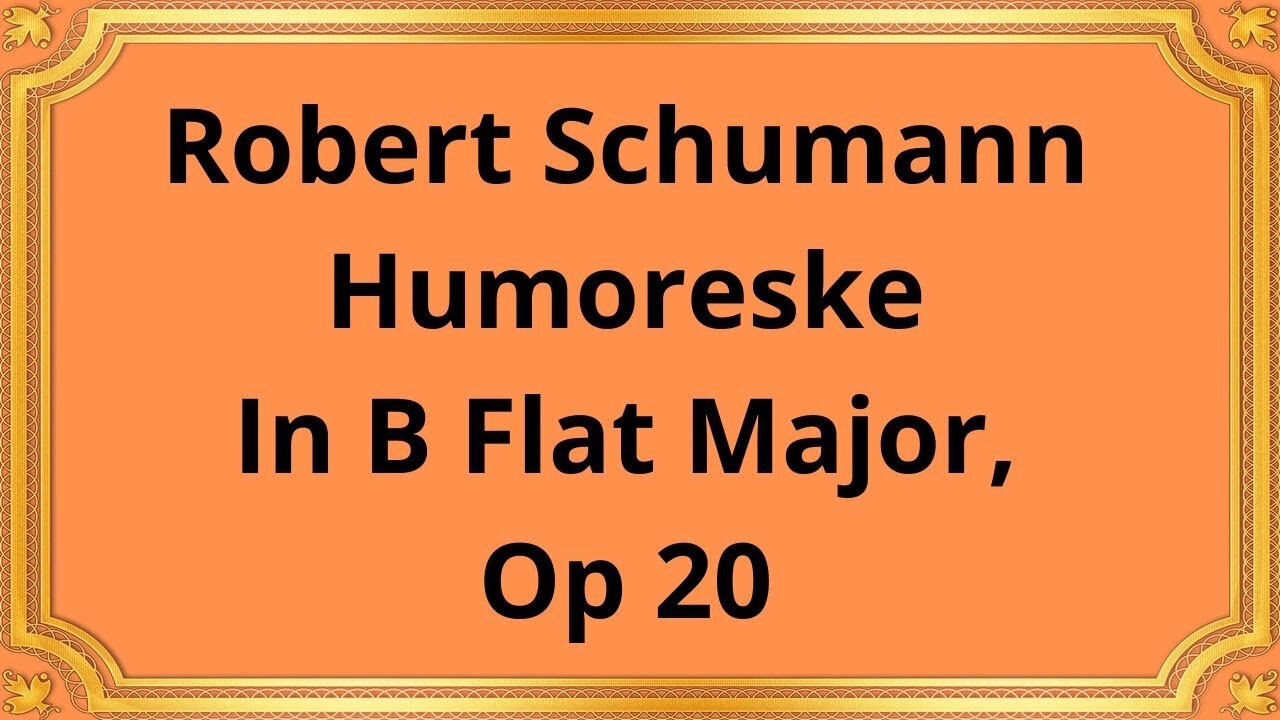Premium Only Content

Robert Schumann Humoreske In B Flat Major, Op 20
#robertschumann #Humoreske #BFlatMajor #Opus20 #ClassicalMusic #MusicalComposition #RomanticEra #Piano #GermanComposer #PianoMusic #CharacterPiece #MusicalExpression #EmotionalDepth #19thCentury #MusicHistory #EuropeanClassicalTradition
Joerg Demus piano
Robert Schumann's Humoreske in B Flat Major, Opus 20, is a captivating musical composition that showcases the composer's unique ability to blend intricate melodies, expressive harmonies, and emotional depth. Written for the piano, this character piece reflects the essence of the Romantic era, capturing the listener's imagination with its whimsical and introspective nature.
Robert Schumann, a renowned German composer of the 19th century, was known for his poetic musical style and his ability to convey profound emotions through his compositions. The Humoreske in B Flat Major, Opus 20, composed in 1839, is a reflection of Schumann's personal experiences and his exploration of the human psyche through music. It is believed to have been inspired by his complex relationship with his future wife, Clara Wieck.
The Humoreske in B Flat Major, Opus 20, is a multi-sectional composition consisting of various contrasting sections. While the piece does not strictly adhere to traditional forms, it is divided into smaller sections that seamlessly flow into one another. Schumann's use of recurring motifs and thematic development creates a cohesive musical narrative.
Humoresque, Op. 20 - Simple - Very quick and easy - Even quicker - First tempo - Hasty - Gradually more legible and stronger - As before - Adagio - Simple and delicate - Intermezzo - Intimate - Faster - Very lively - To the conclusion
The Humoreske explores a wide range of emotions, from playful and lighthearted to introspective and melancholic. Schumann employs a diverse palette of musical techniques, including contrasting dynamics, tempo fluctuations, and virtuosic passages, to express the shifting moods and sentiments within the piece. The composition's whimsical nature is characterized by sudden shifts in mood and unexpected harmonic turns, captivating the listener's attention throughout.
Schumann's Humoreske in B Flat Major, Opus 20, holds significant importance in the realm of classical music. It exemplifies the Romantic era's focus on individual expression, emotional depth, and the exploration of the human condition. The piece showcases Schumann's ability to capture a wide range of emotions and his skill in creating musical narratives that resonate with listeners on a profound level.
Moreover, the Humoreske played a pivotal role in shaping the development of character pieces for the piano. Its innovative approach to musical expression and its blend of virtuosity and lyricism influenced subsequent composers, leaving a lasting impact on the genre. The piece stands as a testament to Schumann's profound musical genius and his significant contribution to the European classical tradition.
Conclusion:
Robert Schumann's Humoreske in B Flat Major, Opus 20, is a masterpiece that continues to captivate audiences with its whimsical and introspective nature. Through its diverse sections and emotional depth, this composition exemplifies Schumann's ability to convey complex emotions through music. Its significance in the world of classical music, as well as its influence on subsequent composers, solidifies its place as a cherished gem within the European classical tradition. The Humoreske serves as a testament to Schumann's genius, leaving a lasting legacy that continues to inspire and delight music enthusiasts around the world.
You have the opportunity to support the channel:
https://destream.net/live/RadSiarAl/donate
https://www.buymeacoffee.com/6355radsiaral
-
 34:26
34:26
Classical music_Music Inspiration
2 months agoAram Khachaturian Concerto for Violin and Orchestra
1092 -
 7:10:15
7:10:15
Illyes Jr Gaming
8 hours agoIt's Wednesday! Let's Hit 300 Followers TONIGHT!
39.9K3 -
 2:40:58
2:40:58
Joker Effect
6 hours agoIs our government safe?***Streamer News***DRAMA***RUMBLE GETTING LEVERAGE***GAMING
56.4K5 -
 14:55
14:55
T-SPLY
10 hours agoDemocrats Accused Of Not Calling Out Joe Bidens Security Disasters
41.6K10 -
 5:08:38
5:08:38
ZachTheRipper
5 hours agoWe Back With A Passion - 0/20 Subs - Interactive Streamer - #RumbleGaming
34.4K -
 16:19
16:19
Tundra Tactical
9 hours ago $1.34 earnedGEN Z Brit 3D Prints a WORKING Gun!
28.6K8 -
 48:01
48:01
Man in America
13 hours agoWHEN WILL THE ARRESTS BEGIN?! w/ General Michael Flynn
38.3K53 -
 3:20:40
3:20:40
BSparksGaming
6 hours agoNear the End? Assassin's Creed Shadows Campaign
23K2 -
 3:08:58
3:08:58
I_Came_With_Fire_Podcast
13 hours agoSIGNAL SNAFU | SODA-GATE | JUDGE STUPIDITY
12.1K5 -
 1:46:34
1:46:34
Glenn Greenwald
9 hours agoThe Truth & Lies About the Atlantic's Signal Controversy; EU Already Failing to Back Up its Militaristic Rhetoric; Appeals Court Rules Against Trump DOJ in El Salvador Case | SYSTEM UPDATE #429
134K122